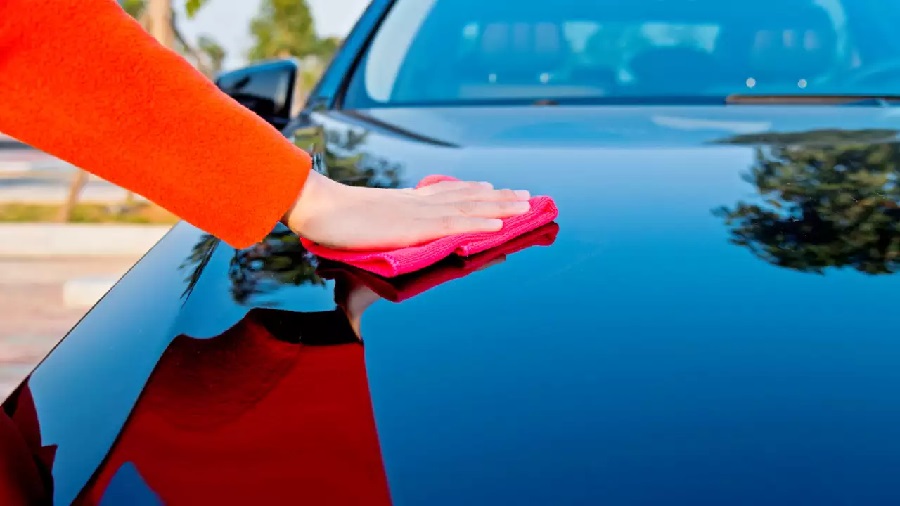Remember that shine when you first picked up the car from the dealer? You could see yourself in the finish.
You vowed to keep it this pristine and looking like new, and maybe you kept up with a washing routine. Every weekend you’re at the car wash or out there on your driveway giving it a good shampoo. How about car waxing?
Car waxing is the secret to that supreme shine. Many people wash their cars routinely but neglect that important car detailing feature that preserves the shiny finish.
If you’re not sure how to wax a car or which product to use, don’t worry. This guide provides everything you need to get started with car waxing, from the supplies you’ll need to step-by-step instructions.
What Is Car Wax?
Car wax is a product made up of natural oils and polymers that form a protective barrier on the paint surface. It helps to repel water and contaminants while also providing UV protection. Waxing your car often will help to keep the paint looking new and prevent fading and damage.
There are two main types of car wax: synthetic and natural. Synthetic waxes are made from man-made ingredients and provide longer-lasting protection than natural waxes.
Carnauba wax is a natural wax that comes from the leaves of a Brazilian palm tree. Carnauba wax is regarded as the finest type of wax for preserving and enhancing automobile paint.
Benefits of Car Waxing
Waxing your car has many benefits that go beyond just making it look good. In addition to protecting the paint and keeping it looking new, waxing also helps to prevent rust metal and corrosion of your car.
Waxing makes cleaning easier by repelling water and dirt and protects against UV damage. The sun is often to blame for your car’s paint being burned out and looking dull over time; waxing protects against this.
Car waxing also makes the car more resistant to scratches and swirl marks.
How Often Should You Wax Your Car?
You should wax your car at least once a season, but more often if you live in an area with harsh weather conditions or if you wash your car frequently.
If you notice that the paint is starting to look dull, or that water doesn’t bead on the surface anymore, it’s time for a new coat of wax.
What You’ll Need to Wax a Vehicle
Gather all your supplies before undertaking this job so you can work quickly. You will need everything you use to wash your car, plus the following supplies:
- Car wax
- A microfiber cloth or sponge
- A clean towel
Start by washing your car well. It’s important to remove any dirt, dust, or grime from the surface before waxing.
You can take your car to the car wash if you’re more comfortable with this. Make sure the car is completely dry before moving on to the next step.
Follow the instructions for the wax you’re using. If you’re using liquid car wax, apply it to a clean microfiber cloth or sponge. If you’re using a paste wax, apply it to a small part of the paint surface.
Work in small sections and use a circular motion to spread the wax evenly over the surface. Pay special attention to the door handles and all the little nooks and crannies of the car.
Try not to apply too much to one area as you may find it difficult to remove. A nice thin layer will do the job.
Allow the wax to dry for the time specified on the product label. This is usually about 15 minutes. You’ll know the wax is dry when it looks matte on your car and almost chalky.
Once the wax is dry, use a clean towel to remove it. A microfiber cloth works well here.
Buff in a circular motion until all of the wax is removed and you’re left with a shiny finish. You can continue to buff with a clean cloth to increase the shine of the finish.
Enjoy your newly waxed car and that amazing shine. Learning to wax your car yourself can reduce your auto detailing cost significantly while offering supreme paint protection.
Tips for Car Waxing
Waxing your car will take some time. Budget for at least two hours to complete the job.
If you’re working in direct sunlight, make sure the paint surface is cool to the touch. Hot surfaces can cause the wax to dry too quickly and be difficult to remove. You may want to try and undertake this job in a covered area or at a cooler time of day.
Waxing your car under shade is a good idea just in case it begins to rain as well. A wet surface will cause the wax to streak. It will also cause the wax to run down on plastic or rubber parts of your car.
Avoid using car wax on plastic or rubber surfaces. These materials can be damaged by the chemicals in car wax. Even if they’re not damaged, wax is hard to remove from these surfaces, making your job that much more difficult.
Keep a soft brush on hand to remove any wax that gets into the cracks of your car right away before it has a chance to harden.
Should You Use a Mechanical Buffer?
A mechanical buffer can make quick work of waxing your car. If you have one and are comfortable using it, go for it.
Just be sure to read the instructions that come with the machine, as they vary. You don’t want to damage your paint job in the process.
Keep Your Car Shiny and New
Car waxing is an important part of the upkeep of your vehicle. It will keep the paint looking shiny and new for many seasons to come. By following this guide, you can wax your car like a pro on your own.
Check out our other auto detailing tips for more ways to keep your car looking amazing.











Comments